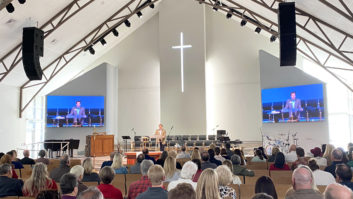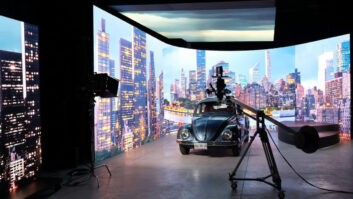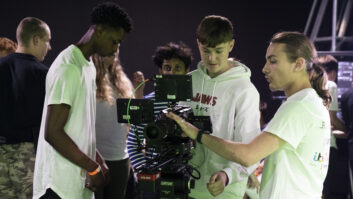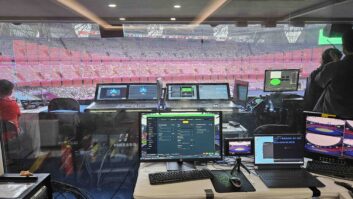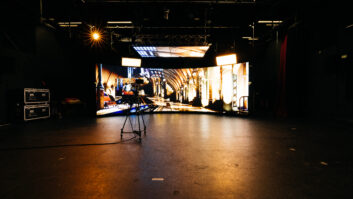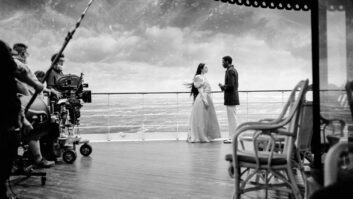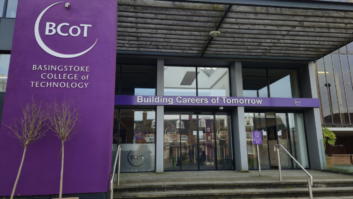Sony has joined the ranks of technology companies offering virtual production space in the UK. Based at Pinewood Studios in Buckinghamshire, and opening on May 16, the company’s Digital Media Production Centre (DMPC) is the first virtual production studio in the UK to include the company’s Crystal LED technology.
The aim of the new studio is to help filmmakers, cinematographers and even actors get to grips with virtual production, which has been increasing in popularity ever since the internet fell in love with Baby Yoda in the first season of The Mandalorian. The DMPC not only includes the Crystal LED screen but also enables visitors to get to grips with Sony’s Cinema line and CineAlta cameras, including the VENICE and VENICE 2 cameras.
The studio is a continuation of the centre’s tradition of bringing together years of knowledge with the newest, cutting-edge technology. 4K cameras were the first products the DMPC showcased when it opened a decade ago, demonstrating both the advances in technology in the past ten years and the history the DMPC has of recognising revolutionary changes early.
NAB UPDATES
Sony recently announced virtual production updates at NAB 2023 in Las Vegas. These include the introduction of the Virtual Production Tool Set, designed to tackle common problems with virtual production and to support quality In-Camera VFX. The key feature of the Tool Set is its Camera and Display Plugin feature, which uses Unreal Engine to connect the real and virtual worlds, achieving synergy between hardware and software to design, visualise and refine the virtual production shots before going into the Virtual Production stage.
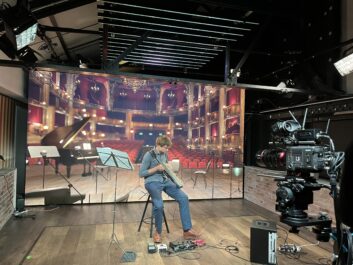 The Pinewood launch, which followed the successful opening of Sony’s first virtual production studio in Europe in Paris in February, took place on May 16-17. At the opening, Sony VP staffers demonstrated the huge cinematic potential of virtual production and explained the technology behind it. There were also opportunities for guests to create stunning visual content in the new studio.
The Pinewood launch, which followed the successful opening of Sony’s first virtual production studio in Europe in Paris in February, took place on May 16-17. At the opening, Sony VP staffers demonstrated the huge cinematic potential of virtual production and explained the technology behind it. There were also opportunities for guests to create stunning visual content in the new studio.
“The purpose of the DMPC is really to focus on in-camera visual effects training and education,” explains Sebastian Leske, Sony’s head of cinema business development, Europe. “We really want to get everyone in here to experience virtual production, to test it and see what you can do.”
Anyone interested in testing out the equipment at the launch was able to sign up via Sony’s website, giving them access not just to the technology but also Sony’s experts who were on site. Leske believes that will prove to be a huge help as virtual production becomes more prevalent across broadcast and live events. “Directors of photography can come in and test out the equipment before they begin shooting. They can come here and prepare themselves for their shoot,” he explains.
HIGH RESOLUTION
The virtual production set-up includes the Crystal LED B-Series (C-LED) screen 4.86 x 2.74m with a resolution of 3072 x 1728, Sony VENICE 2 camera with an 8K sensor, the soon-to-be-released Sony Production Toolset – plus a number of third party products, including NCAM tracking hardware to precisely tell the X Y Z position of the camera in the virtual space, as well as lighting sources from ETC, Sumo Light and Prolycht with DMX control. The set-up has been built and supported by Lux Machina, while grip equipment has been provided by Egripment and Videndum.
The Crystal LED screen at DMPC has been designed for virtual production, with the engineers studying other products on the market before development. “[What we saw was] not as good as we thought it should be because,” says Leske. The screen has also been calibrated to match the colours on the display monitors, which is crucial for cinematographers etc to see exactly what the camera is capturing as it moves about a scene. “The camera is colour consistent so that what is displayed on the LED will be captured on the sensor and then displayed on the production monitor,” adds Leske. “There are no shifts in the colour.”
REDUCED COSTS
Whether production specialists are shooting the latest Star Wars epic, or using virtual production to enhance an episode of Coronation Street, filming on a Volume is expensive.
Leske believes the DMPC will help reduce those costs by giving users the opportunity to understand the shots they want to achieve before they walk on set. “You can set up and test shots you want to shoot in the Volume beforehand so as to avoid mistakes later on,” he says.
“It means DoPs etc can come to Pinewood and test what they want to shoot later on in Hungary or in Los Angeles. They are not wasting time.”
Will Newman, DMPC Manager at Sony, adds: “Virtual Production is set to be the next technological step change for cinematographers, and we were keen to provide them with a space where they can learn and experiment with the opportunities offered by Virtual Production. There’s nothing really like getting hands on, and we know that the combination of our VENICE cameras and Crystal-LED screens are the perfect way to achieve excellent quality images.”
